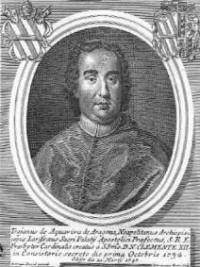Troiano Acquaviva d'Aragona

Troiano Acquaviva of Aragon (Naples, January 14, 1696 - Rome, 20 March 1747) was an Italian cardinal and Catholic archbishop.
Biography
Troiano Acquaviva, was ordained a priest on April 17, 1729. The next day he was elected titular bishop of Plovdiv in Arabia and consecrated bishop on May 3 of that year. In the same year on May 14 he was appointed prefect of the Pontifical Household and 6 July Prefect of the Apostolic Palace. On 14 August 1730 he was appointed titular Archbishop of Larissa.
He was created cardinal by Pope Clement XII in the consistory of October 1, 1732 and November 17 of that year he received the title of Saints Quirico and Giuditta. Then on January 19, 1733 opted for the title of Santa Cecilia, already owned by his uncle Francis.
In the period 1733-1734 he protected Giacomo Casanova, then while in Rome, recommended to him by the [1] powerful Don Lelio Caraffa, Duke of Maddaloni.[2]
In 1734 he became the Spanish ambassador to the Holy See. From 1738 it was cardinal protector of the Kingdom of Naples and Sicily. The May 4, 1739 he was elected Archbishop of Monreale.
He participated in the conclave of 1740, in which he was the bearer of veto by Philip V of Spain against the election of Cardinal Pier Marcellino Corradini. he was also an adviser to Pope Benedict XIV, in the matter of the Churches charges against the King of Naples Charles III of Naples during the war for the succession to the throne of Austria.
From April 1743 he was cardinal protector of Spain and from 3 February 1744 to 25 January 1745, Camerlengo of the Sacred College of Cardinals.[3]
In 1745, succeeding his brother Domenico, he had become the eighteenth Duke of Atri. He died March 20, 1747 after a long and painful illness and Pope Benedict XIV presided at his funeral. He was buried in the Basilica of Santa Cecilia in Trastevere.
References
- ^ Milano, ed. Dall'Oglio, 1964, p. 230 e capp. IX-X
- ^ De rebus ad Velitras gestis Commentarius, di Castruccio Bonamici; Delle cose operate presso Velletri nell'anno 1744 e della guerra italica, tomi 2, trad. it. di Ignazio Montanari, Lucca 1841, vol 1, pp.XXVI-XXXV.
- ^ http://www.fondazionegbvico.org/fvico/xxx/storia.htm
